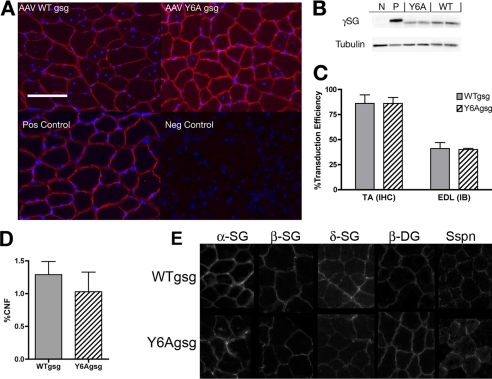FIGURE 1.
Validation of γ-sarcoglycan production after viral injection. A, immunohistochemistry of TA sections demonstrate that both wild type (AAV WTgsg) and mutagenized (AAV Y6Agsg) human γ-SG were properly localized at the sarcolemma in treated gsg−/− mice, compared with C57 (Pos Control) muscle. No expression was observed in uninjected gsg−/− muscles (Neg Control). Costaining by 4′,6-diamidino-2-phenylindole shows that viral expression of either construct stabilized most transduced fibers, which is evident by the peripheral nuclei. Scale bar, 100 μm. B, immunoblotting of EDL muscle lysates show production of both constructs (Y6A, WT) compared with positive control (P, C57BL/6) and negative control (N, gsg−/−) samples. Difference in migration is due to different levels of glycosylation between human and murine γ-SG (Cordier et al., 2001). C, quantification of transduction efficiency 1 month after injection of WTgsg and Y6Agsg. No significant difference in efficiency of expression was observed in muscles treated with either construct by both immunohistochemistry (IHC) or by immunoblotting (IB) (n = 5 for both measurements and each construct). D, quantification of central nucleation (% CNF) in fibers expressing WTgsg or Y6Agsg in the gsg−/− TA muscles. No significant difference was observed between the two treatments. E, immunohistochemistry of TA sections demonstrate that localization of additional members of the sarcolgycan complex, sarcospan (sspn), and β-dystroglycan is restored after injection of WTgsg and Y6Agsg.

